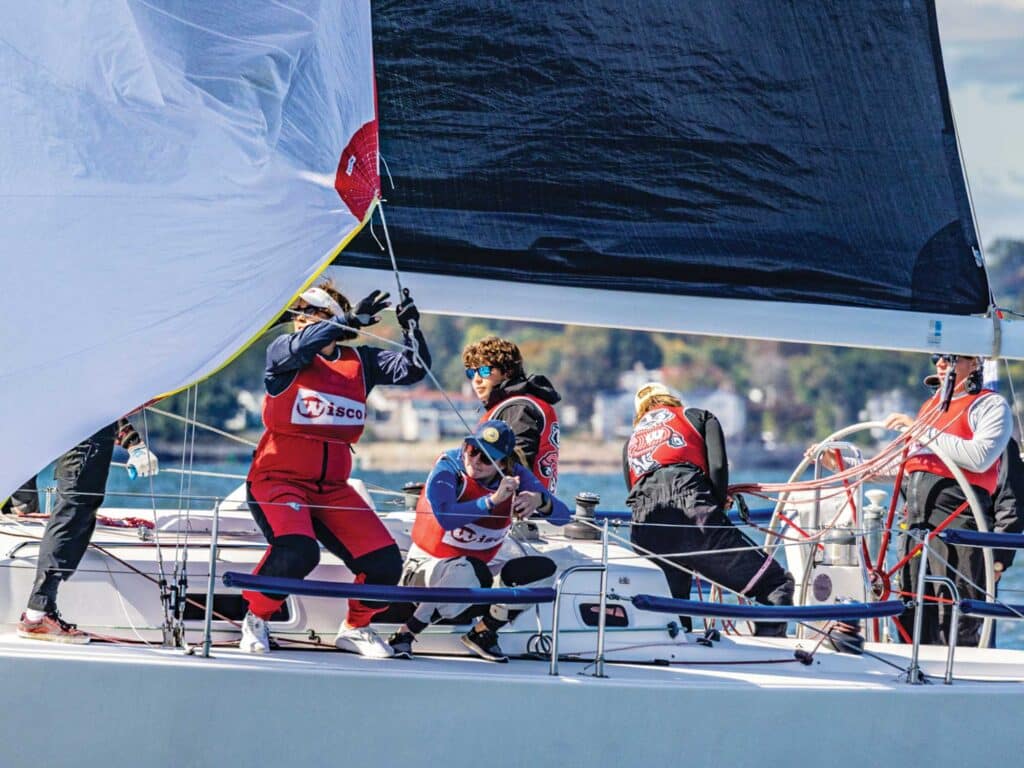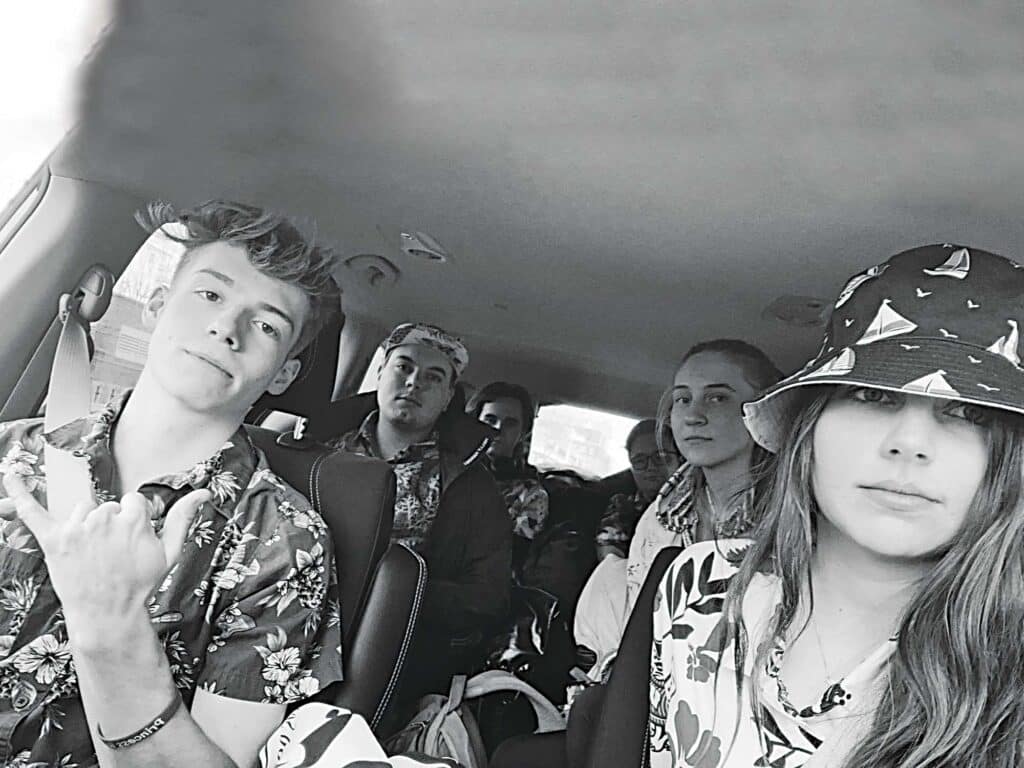
Collegiate keelboat sailing does not get nearly the amount of attention it deserves. While offshore teams were long seen as a secondary option for sailors either too big or not experienced enough to compete in dinghy fleets, several teams are shifting away from traditional collegiate dinghy sailing to focus on the growing number of competitive collegiate offshore regattas held across the country. In the 2022 college offshore season, a new squad made its mark on the world of collegiate keelboat sailing: the University of Wisconsin.
Wisconsin is an unlikely candidate to win in offshore sailing; as a club team that practices on an inland lake, the university is hard-pressed to match the resources of government-funded teams, such as the US Naval Academy, or teams located near coastal sailing hotspots, like the College of Charleston or the University of Rhode Island. However, Wisconsin’s record speaks for itself: Having won the 2022 Intercollegiate Offshore Regatta in Larchmont, New York, and the 2022 Great Lakes Intercollegiate Offshore Regatta in Chicago, it is clear the big-boat Badgers are a force to be reckoned with.
“It’s been really cool to see the Midwest be represented in college offshore sailing,” University of Wisconsin team captain Kate Thickens says. “When I was a freshman, offshore sailing wasn’t cool. Now there are a lot more people on our team interested in sailing big boats, so we are going to as many offshore regattas as we can.”
Wisco’s development of its keelboat program represents a national effort to increase big-boat access to younger sailors. The Larchmont and Great Lakes Intercollegiate Offshore Regattas, hosted by the Storm Trysail Club, are one prong of a sport-wide approach to increasing youth keelboat participation. Over the past decade, regattas such as the Harbor Cup in Los Angeles, the South Carolina Offshore Regatta and the Lake Erie Intercollegiate Offshore Regatta have sprung up to support decades-old regattas such as the IOR series and the US Naval Academy’s Kennedy and McMillan cups in creating a year-round, competitive collegiate offshore racing circuit. The Intercollegiate Sailing Association, College Sailing’s governing body, is also taking steps to bring offshore sailing into collegiate sailing’s fold, now recognizing key offshore events such as the Los Angeles Harbor Cup and Southern Collegiate Offshore Regatta as ICSA events despite them not being hosted by universities.
The addition of collegiate big-boat sailing has allowed swaths of youth sailors who outgrew or lost interest in dinghy sailing to continue to compete at a high level. “Offshore is the land of the misfits,” Thickens says. “It’s a great option for people who are told that they are just too big for college sailing. Obviously, with dinghy sailing, people are very weight-conscious, so they don’t always want somebody that is 6-foot-4 in their boat. I think people like that have definitely found more of a home on the offshore team, where they aren’t being told that they [are] too big. In fact, people will say, ‘Wow, we want you as our mast guy or gal or trimmer because you’re taller and stronger.’”
Competing in a variety of boats during offshore regattas provides the opportunity for new keelboat sailors to learn the skills necessary to continue on after graduation. “A lot of the time, we’ve never even practiced with the exact group that is competing in the event because we’re still building our offshore team,” Thickens says. “I’d say the majority of our effort is toward bringing new sailors into keelboats and teaching people how a winch works or how to fly a spinnaker.”
Access to keelboats remains a challenge for most teams, while the traditional powerhouses of offshore sailing enjoy waterfront facilities with a variety of donated keelboats to train on. The Badgers practice once a week using the Hoofer Sailing Club’s Tartan 10s on inland Lake Mendota. Competing in boats ranging from J/70 sportboats to J/109s and Dehler Optima 101s, the team often does not have the opportunity to train in its class of boat until the day before the regatta. “One thing that helps us do well at events is having a full day of practice on the day before the regatta,” team helmsman Jack Schweda says. “A lot of the time, most or all of the crew hasn’t sailed that specific type of boat before, so the practice day is a huge help.”

What the Badgers lack in facilities, however, they make up for through community support, relying on alumni and friends of the team for coaching. “We’ve had a lot of good chalk talks in the past year or two from alumni and guest speakers,” Schweda says. “Everybody on the keelboat team comes to these chalk talks and learns about how each position works—even positions that they might not be doing. I think that helps because each sailor hears it all; when a sailor gets put on the roster doing a position they have never done before, at least they have been to those chalk talks where they’ve heard the information and can try to work toward doing a good job.”
Located hundreds of miles from the venues where they compete, team members drive through the night in their personal vehicles to sail against top teams. Managing logistical challenges that other teams take for granted brings the team together, Thickens says. “Our drive to regattas is normally anywhere between 15 to 17 hours in the car, but I honestly think that it’s a positive thing. Yes, we are tired, but the drive creates chemistry with the group. This sailing team is one big family—there is no other group of people that I’d rather be packed into a minivan with and be stuck in the back seat. As a freshman, it was really cool to be thrown into these vans with older people on the team and get to know them; there’s really no better way to get to know people.”
While Wisco has been unique in its success in the past year, it represents a growing number of club teams that are taking up offshore sailing and placing on the podium at the highest levels.
While Wisco has been unique in its success in the past year, it represents a growing number of club teams that are taking up offshore sailing and placing on the podium at the highest levels. The similarly club-funded and freshwater University of Toledo placed second in the 2022 Larchmont Intercollegiate Offshore Regatta’s J/105 fleet and won the PHRF A division of the 2022 Lake Erie Intercollegiate Offshore Regatta.
The rise of such teams affirms that collegiate offshore sailing now allows many new or club-status teams an opportunity to take their sailing programs to the next level. While the Navy-hosted McMillan and Kennedy cups still featured the same decadeslong champion keelboat teams, events such as the Larchmont and Great Lakes Intercollegiate Offshore Regattas saw a plethora of club and developing teams the likes of Virginia Tech, Ohio State and Syracuse.
Offshore sailing may also be the way forward for new teams looking to establish themselves in the realm of competitive collegiate sailing and provide opportunities for sailors to thrive in the sport as experienced keelboat crews. Connecting collegiate sailors with race-boat owners provides a viable and sustainable solution to supporting local racing scenes with a deeper and younger pool of available crews.









